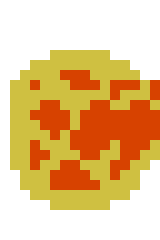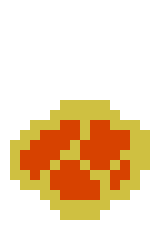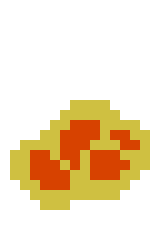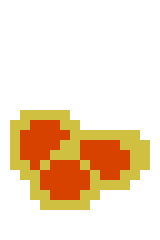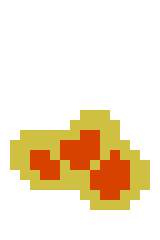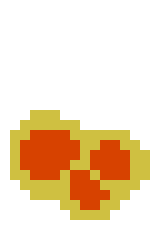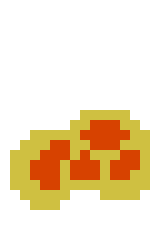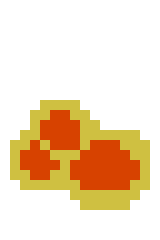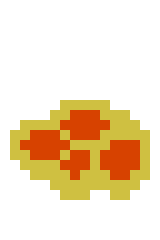Lava
| When on/in other objects/liquids: | |
|---|---|
| {{{adjective}}} liquid {{{smeared}}} object {{{stained}}} object | |
Starts Flaming at
|
4000° |
Vaporizes at
|
99999° |
Base temperature
|
25° |
Cooking Effect
|
|
Value per dram
|
50 |
Weight per dram
|
0.25# |
Prompt to wade through?
|
no |
Prompt to drink?
|
no |
ID
|
LavaPool, LavaPuddle,SmallLavaPuddle |
Liquid ID
|
lava |
Infobox data from game version 2.0.196.1
| |
lava is a liquid made out of melted rock. It is one of the higher valued liquids, but is highly harmful to anything it contacts that lacks proper heat resistance. Cooking with it grants simple heat and fire-based cooking effects. A composite liquid containing lava will be magmatic.
Upon entering a cell of lava that is not frozen, the creature's temperature will increase by 1,000, which is often enough to set the creature on fire. This is only when the cell is entered, and staying on the lava will not alter temperature directly. However, there is a high risk of lava staining and covering the creature and their items repeatedly if they do not leave the cell.
When lava is poured on something, their temperature will increase by 1,000 and take 1d201-20 (Avg: 10.5) damage for every dram poured. Drinking it is even more dangerous, increasing temperature by the same amount, but the imbiber takes 1d1001-100 (Avg: 50.5) damage. Drinking lava grants the On the Rocks achievement. In the journal, this is noted as "Unexplainably, you drank lava".
Storing lava
| This article may need cleanup to meet quality standards.
Please help improve this page by editing it. Reason: "This needs to be beoken up into smaller paragraphs and simplified. Also, favilinks should only be used for the first time an item is mentioned." |
Please help improve this page by editing it.
Reason: "This needs to be beoken up into smaller paragraphs and simplified. Also, favilinks should only be used for the first time an item is mentioned."
Please help improve this page by editing it.
Reason: "This needs to be beoken up into smaller paragraphs and simplified. Also, favilinks should only be used for the first time an item is mentioned."
In terms of proper receptacles for storing lava, any container that has a flaming temperature that is higher than 1,000. There are two dedicated liquid containers that can withstand this temperature, the ![]() phial and the
phial and the ![]() glass bottle, however, a
glass bottle, however, a ![]() glass bottle can only safely hold up to 6 drams of lava once. Only after pouring more than 6 drams of lava or pouring lava into the
glass bottle can only safely hold up to 6 drams of lava once. Only after pouring more than 6 drams of lava or pouring lava into the ![]() glass bottle multiple times will the bottle start flaming. Due to the fact a
glass bottle multiple times will the bottle start flaming. Due to the fact a ![]() glass bottle is 100 times cheaper than a
glass bottle is 100 times cheaper than a ![]() phial, and can hold more drams, it seems the most cost-effective way to trade lava (without using cooling) is with a
phial, and can hold more drams, it seems the most cost-effective way to trade lava (without using cooling) is with a ![]() glass bottle, but the 6 dram lava bottle weights 8 lbs, instead of the 1 lb
glass bottle, but the 6 dram lava bottle weights 8 lbs, instead of the 1 lb ![]() phial. This means that you can hold significantly less lava than if you had infinite phials in comparison to infinite glass bottles. For example: if a player has 300 lbs of free space, he can hold 37(.5) 6 dram lava bottles and 300 phials of lava. 37 (bottles) times 6 (drams of lava) is 222, so the
phial. This means that you can hold significantly less lava than if you had infinite phials in comparison to infinite glass bottles. For example: if a player has 300 lbs of free space, he can hold 37(.5) 6 dram lava bottles and 300 phials of lava. 37 (bottles) times 6 (drams of lava) is 222, so the ![]() glass bottle would "lose" 78 drams of lava in comparison to the
glass bottle would "lose" 78 drams of lava in comparison to the ![]() phial. However, the investment cost is way lower. If we presume that the player bought all of these phials and glass bottles empty the player would have to spend 300 drams of water on phials but only 0.37 drams of water on glass bottles. This investment cost however, is negated by the profit gained from the trade. With this example, currently the
phial. However, the investment cost is way lower. If we presume that the player bought all of these phials and glass bottles empty the player would have to spend 300 drams of water on phials but only 0.37 drams of water on glass bottles. This investment cost however, is negated by the profit gained from the trade. With this example, currently the ![]() phial lava trade has a profit of 14700 drams of water, and the
phial lava trade has a profit of 14700 drams of water, and the ![]() glass bottle lava trade has a profit of 11099.63 drams of water. The
glass bottle lava trade has a profit of 11099.63 drams of water. The ![]() glass bottle lava trade would lose 3600.37 drams of water in comparison to the
glass bottle lava trade would lose 3600.37 drams of water in comparison to the ![]() phial trade. However, this is all if we pretend those 78 drams of lava can never be reached again. Currently, lava does not disappear, so if we go back for those 78 drams of lava, the total amount of water drams profit gained by the
phial trade. However, this is all if we pretend those 78 drams of lava can never be reached again. Currently, lava does not disappear, so if we go back for those 78 drams of lava, the total amount of water drams profit gained by the![]() glass bottle trade would be (300 drams of lava * 50 value per dram - ((300 drams of lava / 6 drams per bottle) * 0.01 price per bottle)) 14999.5 drams of water, so 299.5 drams more in comparison to the lava phials. The unfortunate side effect of this is that all the phials can be filled by pressing the "collect liquid" option. Glass bottles cannot be filled this way, and have to be manually filled by using the pour option. This means that if you choose to do the
glass bottle trade would be (300 drams of lava * 50 value per dram - ((300 drams of lava / 6 drams per bottle) * 0.01 price per bottle)) 14999.5 drams of water, so 299.5 drams more in comparison to the lava phials. The unfortunate side effect of this is that all the phials can be filled by pressing the "collect liquid" option. Glass bottles cannot be filled this way, and have to be manually filled by using the pour option. This means that if you choose to do the ![]() phial trade instead of the
phial trade instead of the ![]() glass bottle trade, you are paying the game 299.5 drams of water for manual labor and (extra) shipping. Phials are rarer than glass bottles, so the
glass bottle trade, you are paying the game 299.5 drams of water for manual labor and (extra) shipping. Phials are rarer than glass bottles, so the ![]() glass bottle trade can usually be done more easily. If buying glass bottles from
glass bottle trade can usually be done more easily. If buying glass bottles from ![]() ichor merchants, the player has to keep in mind that every bottle under (6 drams of lava * 50 price per dram) 300 drams of water is effectively profit, if the player can create lava or has lava. However, prices are dependent on your Ego level, so it might be useful to see how much your lava and their bottles are worth.
ichor merchants, the player has to keep in mind that every bottle under (6 drams of lava * 50 price per dram) 300 drams of water is effectively profit, if the player can create lava or has lava. However, prices are dependent on your Ego level, so it might be useful to see how much your lava and their bottles are worth.
Some artifacts that can hold liquid as ammo can also hold lava without being destroyed. Notable examples include all liquid fueled energy cells, ![]() gyrocopter backpacks,
gyrocopter backpacks, ![]() rocket skates, and
rocket skates, and ![]() flamethrowers.
flamethrowers.
Sources of Lava
- Any wall that reaches its melting point will turn into 2,000 drams of lava
 giant lava weeps and
giant lava weeps and  lava weeps. Fungal biomes that contain these have bright red and yellow mushrooms.
lava weeps. Fungal biomes that contain these have bright red and yellow mushrooms.- Rarely sold by
 ichor merchants and
ichor merchants and  chefs.
chefs.
- Note that this lava will sometimes be sold in non-lava safe containers, in which case the containers will be flaming in their inventory.
- The
 alchemist is guaranteed to have one dram of lava for sale.
alchemist is guaranteed to have one dram of lava for sale.
- This dram will be sold in a
 phial, which the lava cannot destroy.
phial, which the lava cannot destroy.
- This dram will be sold in a
- When killed,
 red jells leave a pool of lava in the same way that
red jells leave a pool of lava in the same way that  giant amoebas leave a pool of
giant amoebas leave a pool of  slime.
slime. - Found in the deeper levels of the
 Asphalt Mines
Asphalt Mines - Left behind by red-colored ("hot")
 machine walls when they are destroyed.
machine walls when they are destroyed.
Uses of Lava
- Used in
 thermoelectric cells to power artifacts
thermoelectric cells to power artifacts - Can be cooked with
- High commerce value per dram
Tips
- An easy source of large single-target, single-hit damage, making it potentially useful, e.g., for killing a
 mercurial without it teleporting away. However, this will anger them if they survive.
mercurial without it teleporting away. However, this will anger them if they survive. - Lava can be collected after the initial pouring to be reused for damage, although it will be halved due to mixing with the salt on the ground.
- Because any wall can melt into lava, characters with heat-based mutations, such as Flaming Hands or Pyrokinesis, can make lava without having to search for it.
- Lava can be poured on someone to remove the frozen effect. However, this often results in upwards of 100 damage, so it is best used only as a last resort.
 molten wax is much safer, though not as effective.
molten wax is much safer, though not as effective.
| |||||
